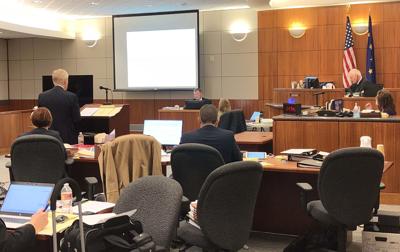The Alaska Supreme Court ruled Friday that Williams Alaska, the old owner of a petroleum refinery in North Pole, will be financially liable for the contamination of surrounding groundwater wells.
The 91-page opinion also upholds an Alaska Superior Court ruling that the city of North Pole was not responsible for the contamination, despite the old owner’s legal arguments.
Thank you for reading!
Please log in, or sign up for a new account and purchase a subscription to continue reading.
We have used your information to see if you have a subscription with us, but did not find one. Please use the button below to verify an existing account or to purchase a new subscription.
Your current subscription does not provide access to this content. Please use the button below to manage your account.
In a prepared statement, Alaska Attorney General Treg Taylor called the ruling a “huge win for the public, for the environment, and for the state.”
“We are very pleased that the Alaska Supreme Court affirmed the trial court’s ruling holding Williams accountable for decades of releasing hazardous substances into North Pole’s drinking water aquifer,” Taylor said.
Williams Alaska owned and operated the old refinery near Energy Way from 1977 to 2004, before being sold to Flint Hills Alaska. Williams used sulfolane in the refining process, which seeped into the water table due to spills and poor maintenance.
According to the court, Williams detected the chemical contamination as early as 1996 but did not report it to the Alaska Department of Environmental Conservation until 2001. The lab manager had found sulfolane concentrations “ranging from 250,000 to 2.7 parts per billion.
“DEC instructed Williams to continue sampling the groundwater until it found the contamination source. DEC informed Williams it could reduce sampling frequency if its data were not changing and it could not find a source,” the court wrote. “Williams was not able to determine the specific source and stopped sampling altogether in July 2002.”
In addition to sulfolane, Williams also used firefighting foam containing per- and polyfluoralkyl substances or “forever chemicals” (PFAS) for its fire response practices.
According to a May 2023 Alaska DEC report, the plume of combined sulfolane and PFAS extended 3.5 miles north-northwest of the refinery.
Sulfolane was detected in 2009 in drinking water wells and Flint Hills provided the city with new wells and bulk water deliveries to affected residents.
The city, state and Flint Hills expanded its water system to include impacted properties inside and outside city limits, with a total of 652 new connections.
Williams Alaska sold the company to Flint Hills in 2004. The purchase agreement included “detailed provisions about the assumption or retention of liabilities related to all aspects of the refinery’s operations, including environmental liabilities.”
The agreement also stipulated both parties would hold each other harmless for costs from those respective retained liabilities and that Williams would retain most of the environmental liabilities.
Flint Hills and the state of Alaska took Williams Alaska to court in 2014, seeking to place the cost of cleanup and containment on Williams.
Attorneys for Williams Alaska made several arguments in its defense, such as sulfolane wasn’t harmful, the DEC provided negligent oversight, the refinery’s sale capped clean-up damages and the state was unconstitutionally taking assets from Williams Alaska.
During a 16-day superior court trial in 2019, the state called in several experts who testified about sulfolane’s toxicity based on several governmental and scientific reports and the chemical’s link to several health issues when humans were exposed to it.
The state also called Bryce Ward, who had been North Pole’s mayor, who testified “about the negative impact sulfolane contamination had on the North Pole community, causing residents to be upset and concerned about the amount of sulfolane to which they were unwittingly exposed.”
According to the Supreme Court ruling, the superior court judge estimated clean-up costs approached $100 million. The amount includes efforts by the state and Flint Hills to provide bulk water deliveries to affected residents, setting the homes up on piped water, setting up new wells for the city of North Pole and future oversight costs.
In its appeal to the Superior Court, Williams Alaska argued the superior court erred in its estimate for piped water costs, “claiming the piped water system was unnecessary, not cost-effective, and unreasonable.”
The Supreme Court upheld most of the superior court’s rulings, including that there was enough evidence supporting sulfolane’s danger to human health and that piped water was warranted.
“There was also sufficient evidence in the record that the contamination was caused by ‘unreasonable” conduct,’” the court wrote. “Williams itself treated sulfolane as a hazardous substance and was aware of potential, if not yet established, environmental impacts.”
Another argument the Supreme Court agreed with includes the justification for piped water.
“The superior court found that the public’s loss of its ability to access uncontaminated groundwater was an independent harm that was not addressed by providing alternate water supplies,” the Supreme Court wrote. It added the lack of piped water for homes on top of contaminated groundwater limits options of available water sources.
Flint Hills eventually stopped refinery operations in 2014. The old property was purchased by Marathon Petroleum in 2019, according to the Alaska DEC.
The city of North Pole is currently pursuing federal grant funding to build a combined natural heat and power plant on the old site, with an agreement from Marathon.

